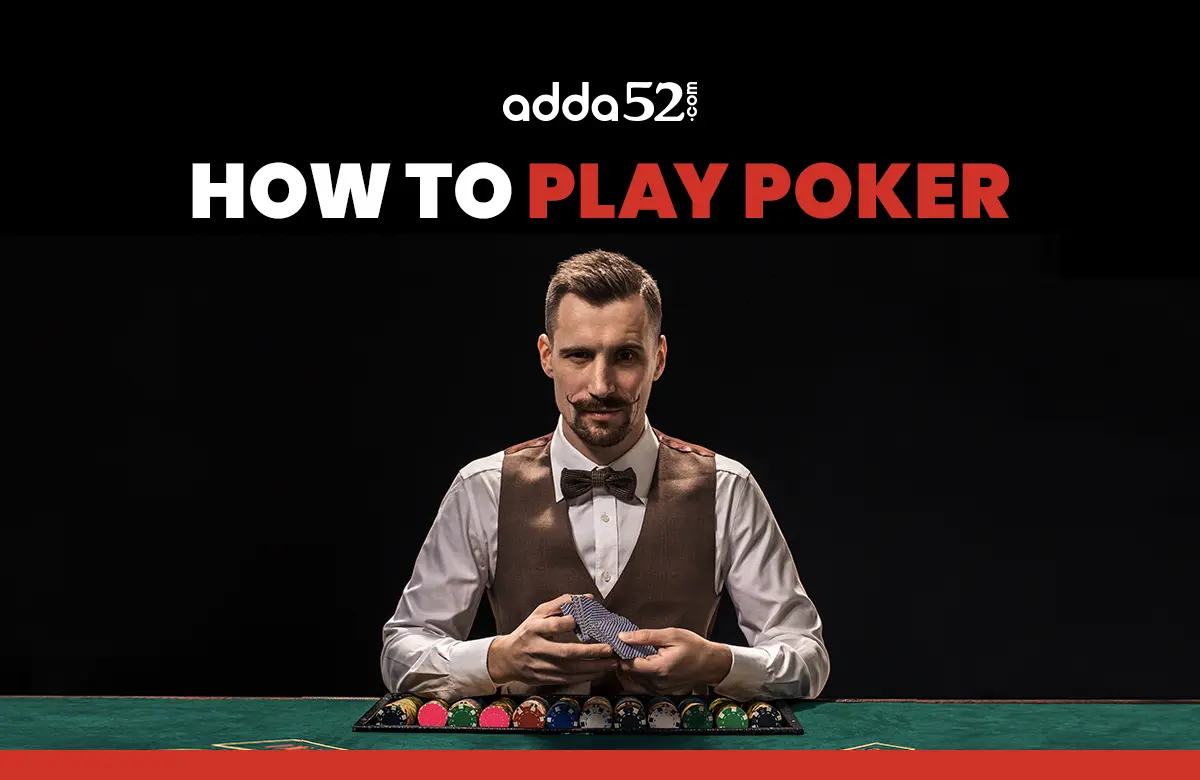
Poker is a fascinating card game where skill meets strategy, and every hand is a chance to outplay your opponents. In this game, the players aim to have the best hand or bluff their way to victory. This article will guide you through the basics, from understanding how to play poker to mastering essential concepts like table positions and betting actions.
Whether you are a beginner looking to learn poker rules or an experienced player seeking advanced strategies, this article will give you everything you need to know about playing poker and poker game rules. Let’s learn to play poker.
One of the best ways to learn poker online is by participating in freeroll games on a poker app like Adda52. Freeroll games allow you to play poker against other players without risking any money.
How to Play Poker for Beginners
Understanding the basic poker rules is crucial for beginners, as this will help them play better poker.
Basic poker rules
The basic poker rules are as follows:
- The goal is to make the highest 5-card hand ranking sequence.
- Players can call, bet, raise or fold when it is their turn to act.
- A showdown occurs when only two players remain after the last betting round, and their cards are compared. The player with the higher-ranking hand wins the pot.
- When players bet or make a raise and the rest of the players fold, they win the round before reaching the show.
Poker Hand Rankings:
Poker hand rankings are essential to understand if you want to play the game.
Hand ranking will help you determine the strength of your hand and whether or not you should bet, call, or fold.
- Royal Flush: (A♥ K♥ Q♥ J♥ 10♥ )
- Straight Flush: (5♥ 6♥ 7♥ 8♥ 9♥ )
- Four of a Kind: ( Q♥ Q♥ Q♦️ Q♣️ 5♥ )
- Full House: (Q♥ Q♥ Q♦️ J♥ J♥ )
- Flush: (2♥ 5♥ 9♥ J♥ K♥ )
- Straight: (2♥ 3♣️ 4♦️ 5♦️ 6♥).
- Three of a Kind: (J♥ J♣️ J♦️ 3♥ 7♦️)
- Two Pair: (Q♥ Q♦️ 10♥ 10♦️ 8♣️)
- Pair: (J♥ J♣️ 8♦️ 3♥ 7♦️)
- High Card: (J♥ 6♣️ 8♦️ 3♥ 7♦️).
Royal Flush: It is the highest and the strongest poker hand. It consists of 10-J-Q-K-A of the same suit.
Straight Flush: A straight flush is five cards from the same suit in sequential order. The highest straight flush is 9-10-J-Q-K, while the lowest is A-2-3-4-5.
Four of a Kind: Four cards of the same rank.
Full House: A full house comprises three of a kind and a pair.
Flush: Five cards of the same suit, not necessarily in the same order.
Straight: Five cards in a sequential order irrespective of the suit. Example: 5♦ 6♣ 7♦ 8♠ 9♣.
Three of a kind: Three cards of the same rank.
Two Pair: Two sets of pairs, each consists two cards of the same rank.
Pair: Two cards of the same rank.
High Card: The highest ranking card in your hand.
Poker Positions:
Your position at the table can significantly affect your strategy. Players who act later in the betting round have more information and, therefore, have an advantage.
In poker, table position refers to the player's position in relation to the dealer button, and it can significantly impact how a hand is played. There are three main types of table positions in poker: early, middle, and late.
Early position:
Players in early position are the first to act in a betting round. It includes the Small Blind, the Big Blind, Under the Gun (UTG), UTG+1, and UTG+2. Players in early position have the least information about the other players' hands and should generally play tighter and more conservatively.
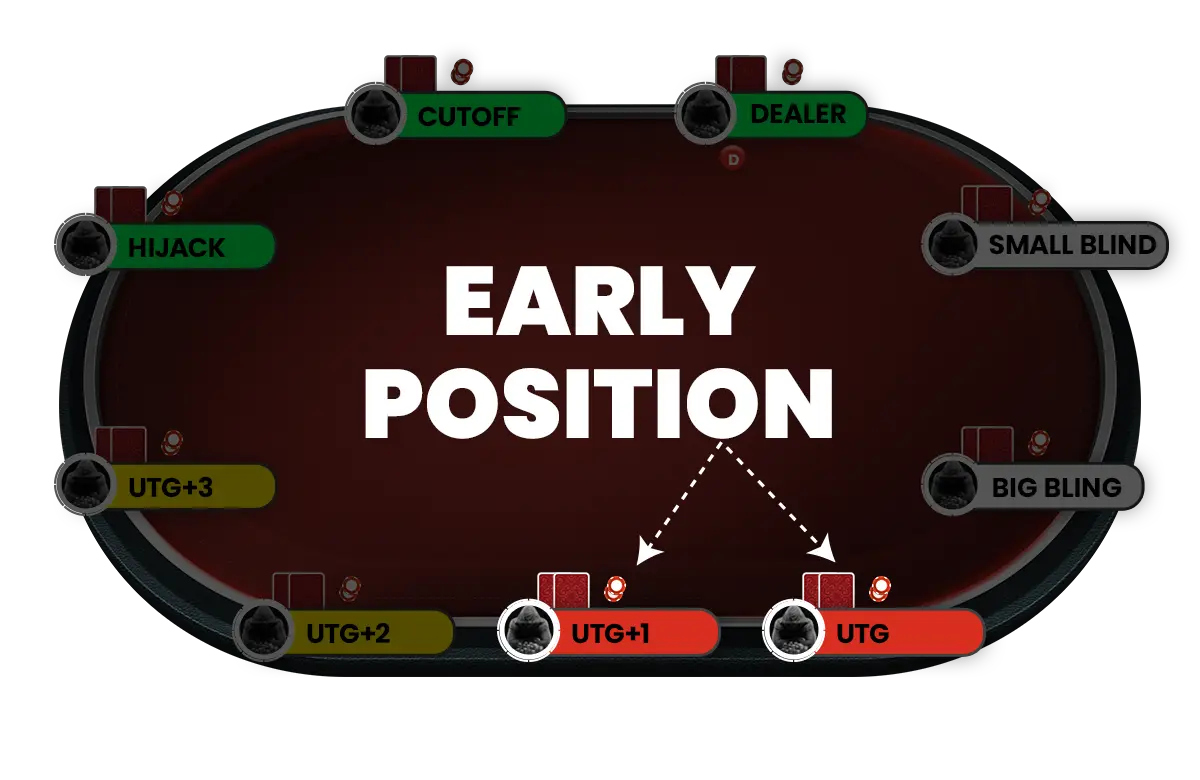
Middle position:
Players in the middle position, including Lojack and Hijack, are better positioned to gather information about their opponents than those in the early position.
Middle-position players have more options and can play a broader range of hands. They should be more selective with their starting hands but can be more aggressive when the opportunity arises.
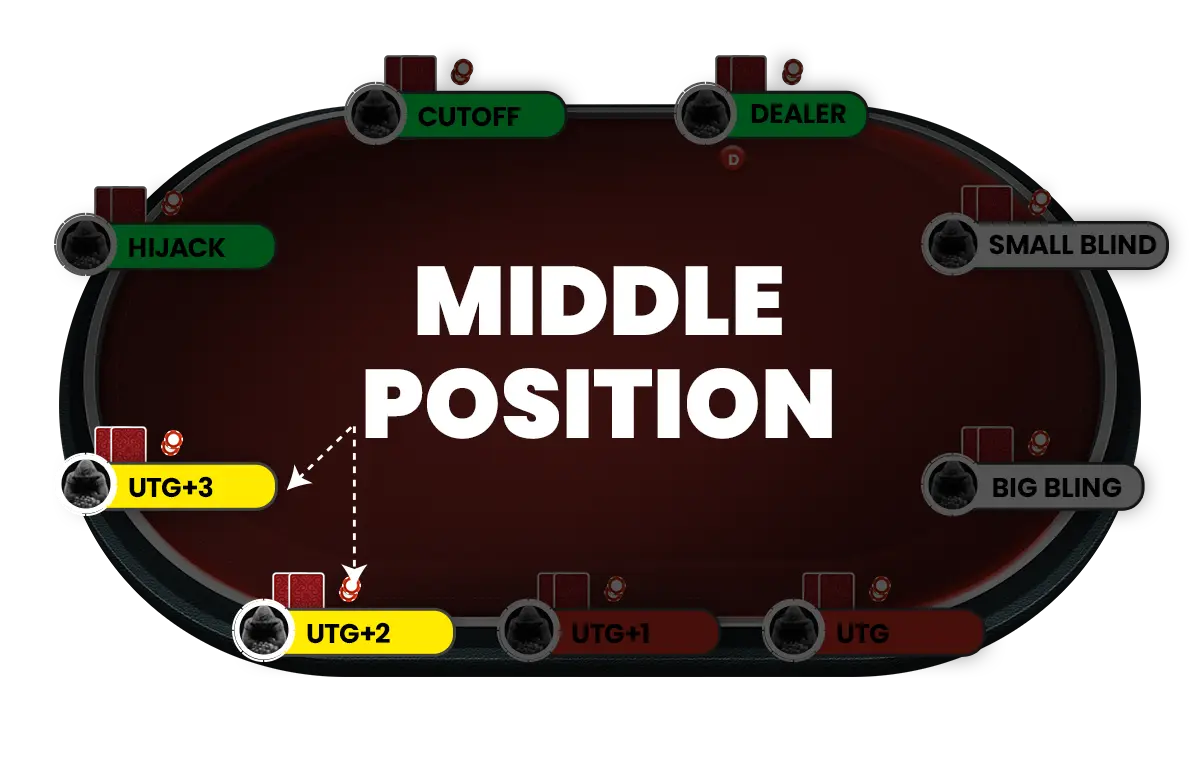
Late position:
Players in late position have the most information about their opponents and can use this to their advantage. It includes a Cutoff and button (or dealer).
Late-position players can play a broader range of hands and be more aggressive with their betting and raises. They should take advantage of their position and build the pot when possible.
It is important to know that the table position is not fixed and can change from hand to hand as the dealer button rotates clockwise. Understanding the dynamics of table positions can help players make more informed decisions and improve their poker strategy.
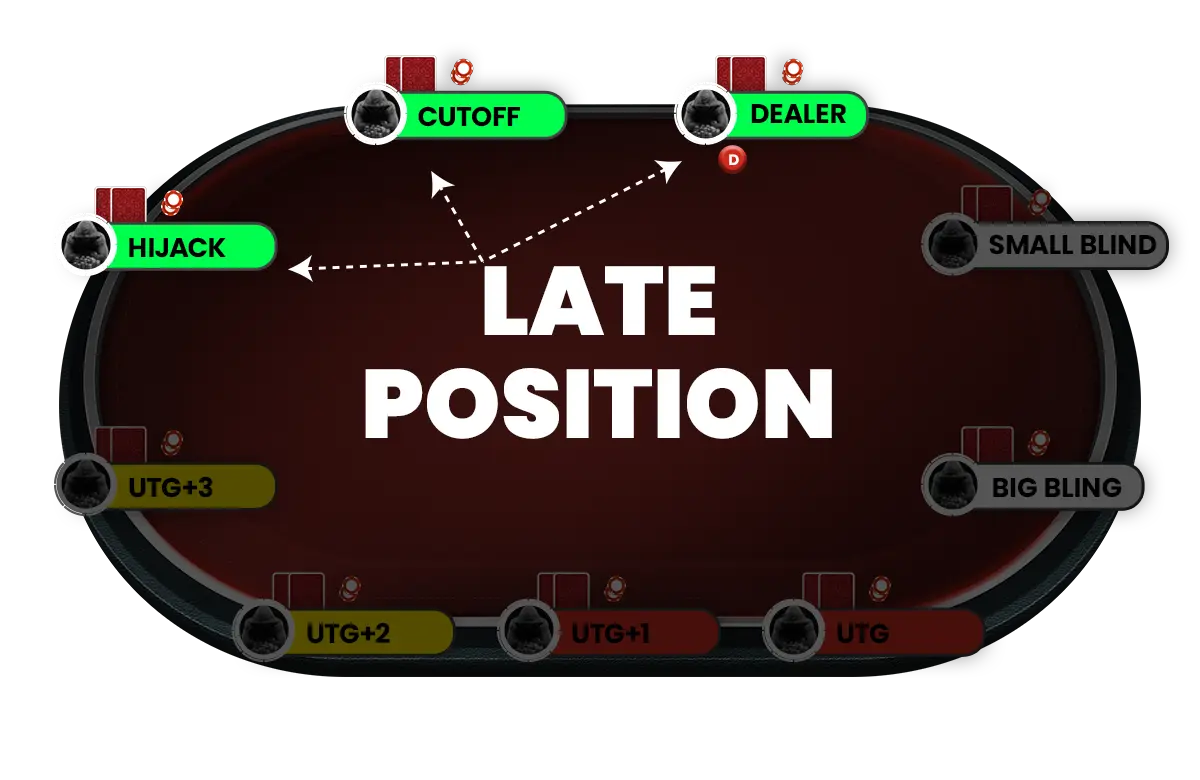
Dealer Button
A dealer button is a small circular disc that indicates which player is the dealer for a particular hand. It is typically passed clockwise around the table after each hand so that each player has a chance to be the dealer.
The position of the dealer button plays a critical role in determining the order of betting and the positions of the blinds, which can affect the game strategy. The button is also used to determine the order of card distribution in certain games, such as Texas Hold'em and Omaha.
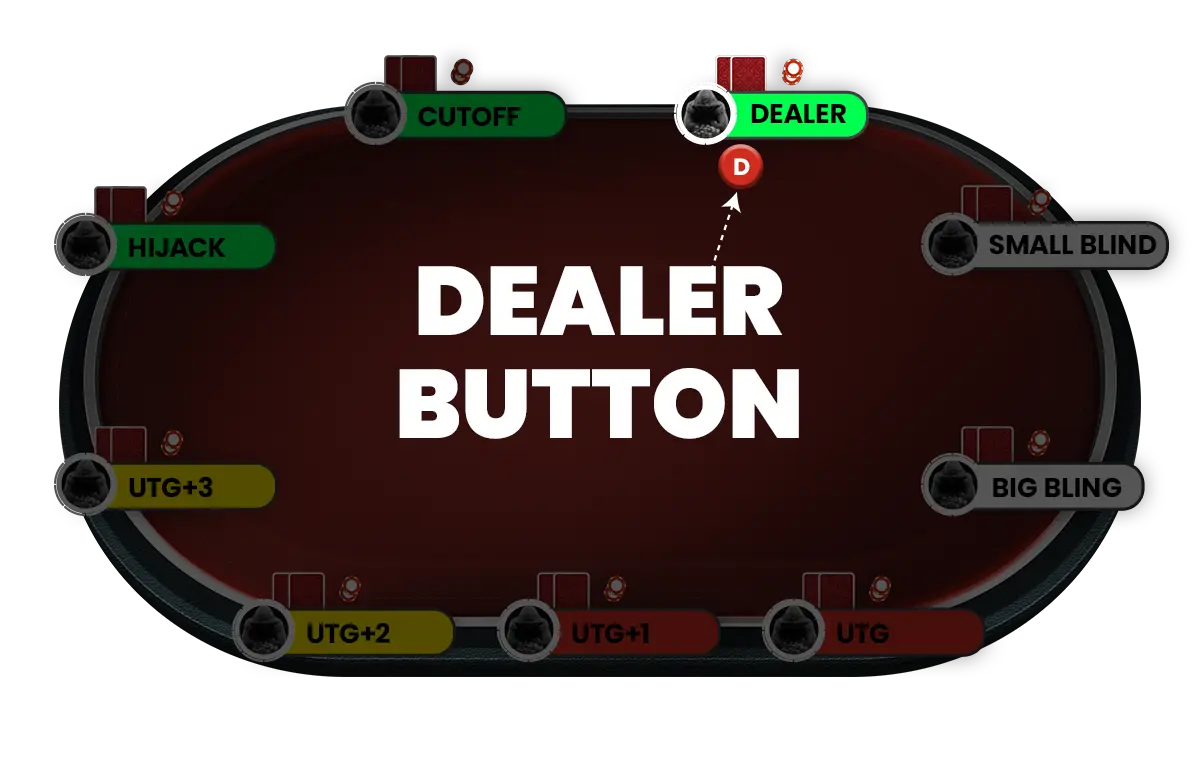
Blinds and Antes
Antes
Ante refers to a mandatory bet that all players must contribute to the pot before each hand begins. It ensures there is always something at stake and encourages active participation. Antes vary in size, helping build the initial pot and adding a thrill to each round of play.
For example: If the ante is Rs. 20, all the players must pay the additional 20 before the cards are dealt.
The Small Blind and Big Blind
In poker, the small and big blinds are forced bets posted by the players to the left of the dealer button. The small blind is typically half the minimum bet for a particular hand, and the big blind is the full minimum bet. Blinds help stimulate action and build the pot before players receive their cards. After posting blinds, players proceed with betting rounds.
For example, in a table of ₹50/ ₹100, ₹50 is small blind, and ₹100 is big blind.
Betting Rounds in Poker:
Preflop:
The first betting round starts with the player to the left of the big blind (the player who must post a "blind" bet before the cards are dealt).
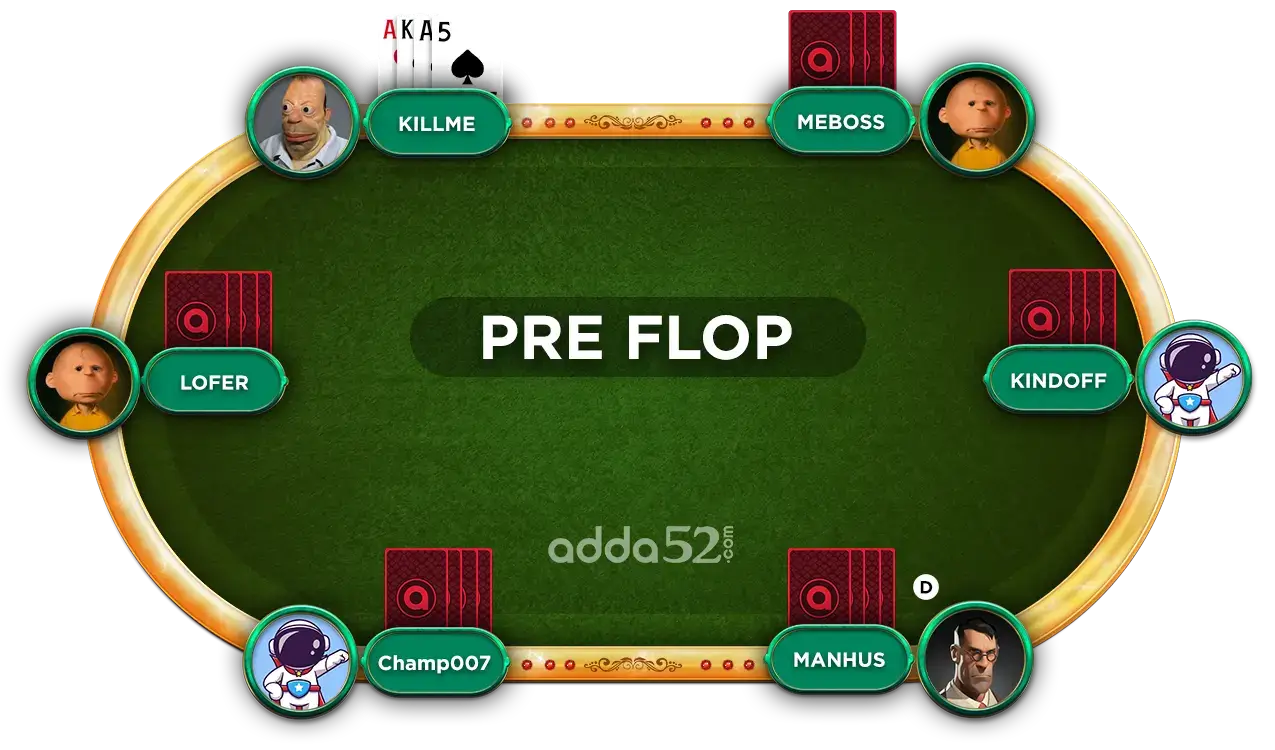
The Flop:
The dealer then deals the first three community cards called the flop. The second betting round begins with the player to the dealer's immediate left.
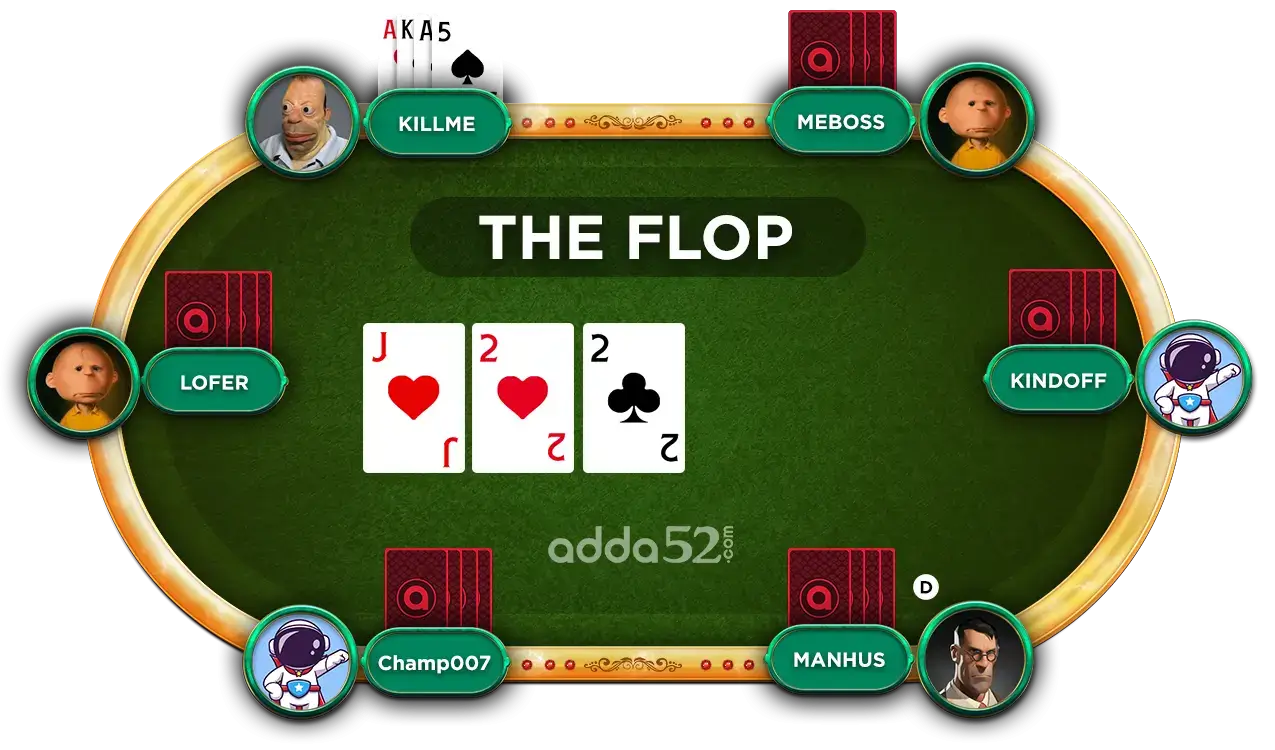
The Turn:
The dealer then deals the fourth community card, called the turn. The third betting round starts with the player to the dealer's left.
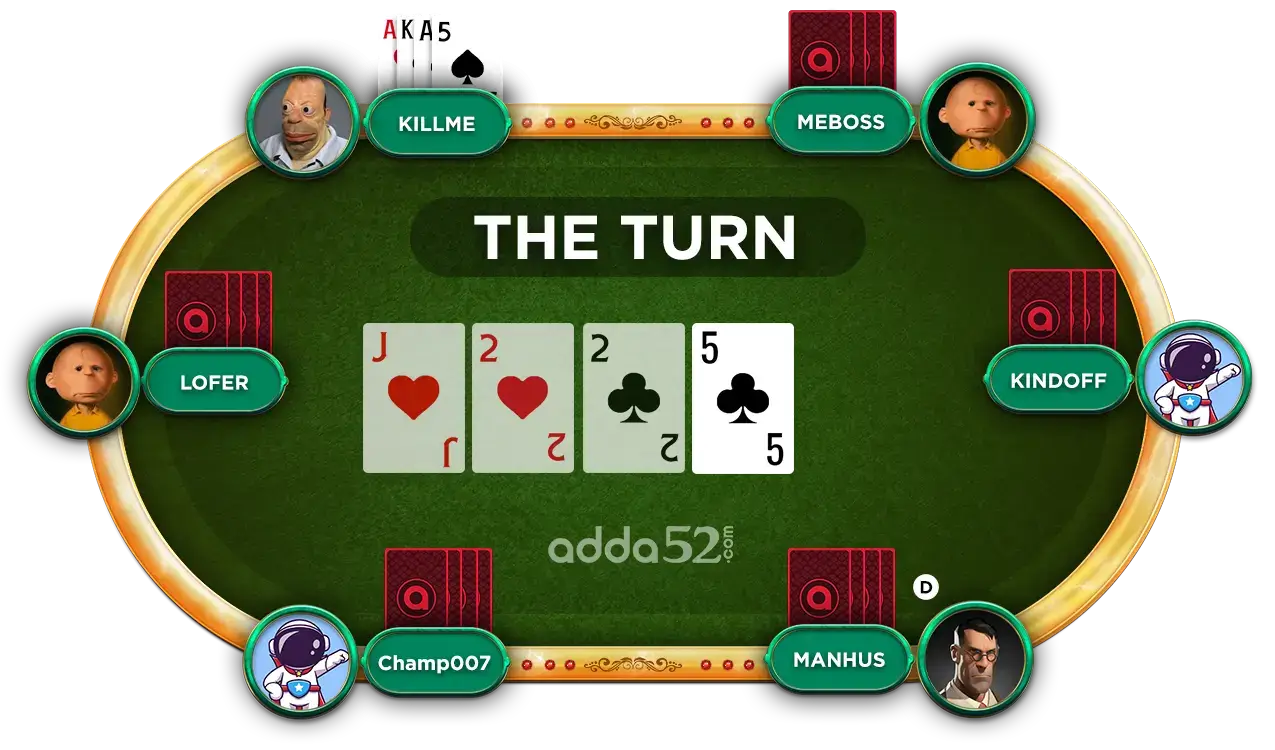
The River:
The dealer then deals the fifth and final community card called the river. The fourth and final round of betting starts with the player to the dealer's left.
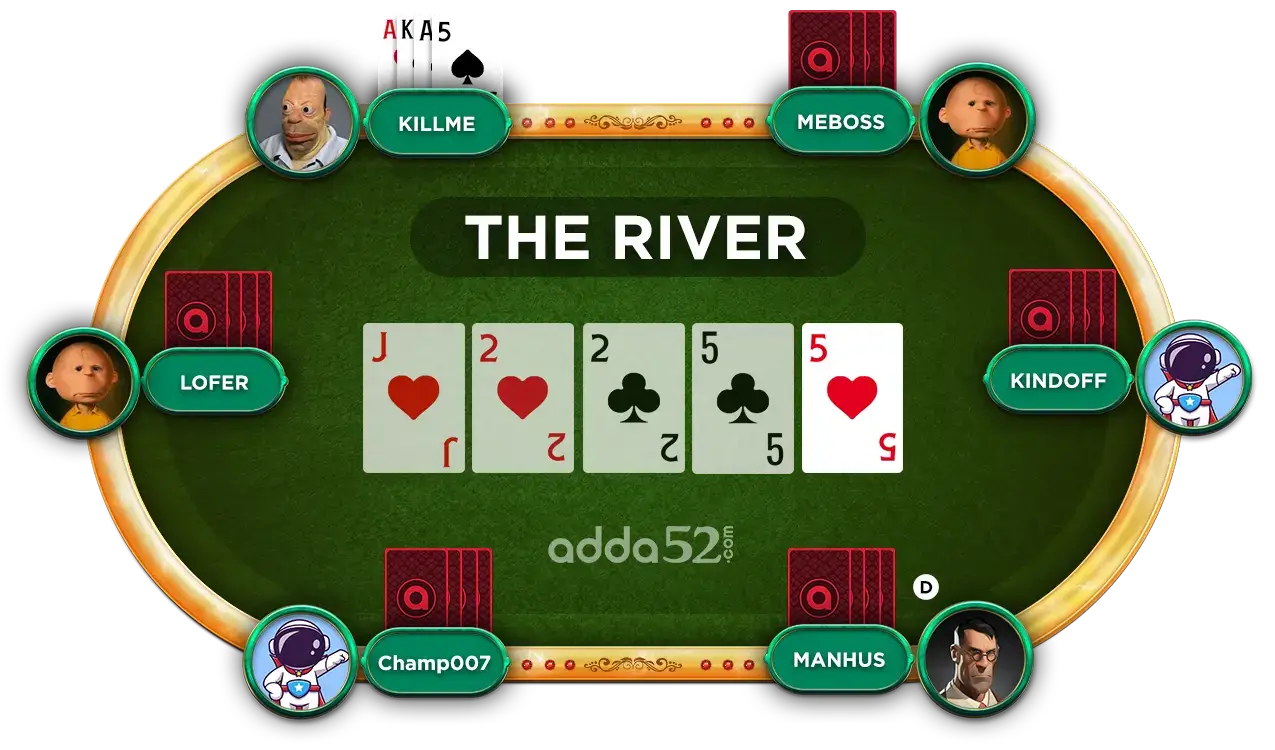
The Showdown:
If more than one player is left after the final round of betting, a showdown occurs, and the player with the best hand wins the pot.
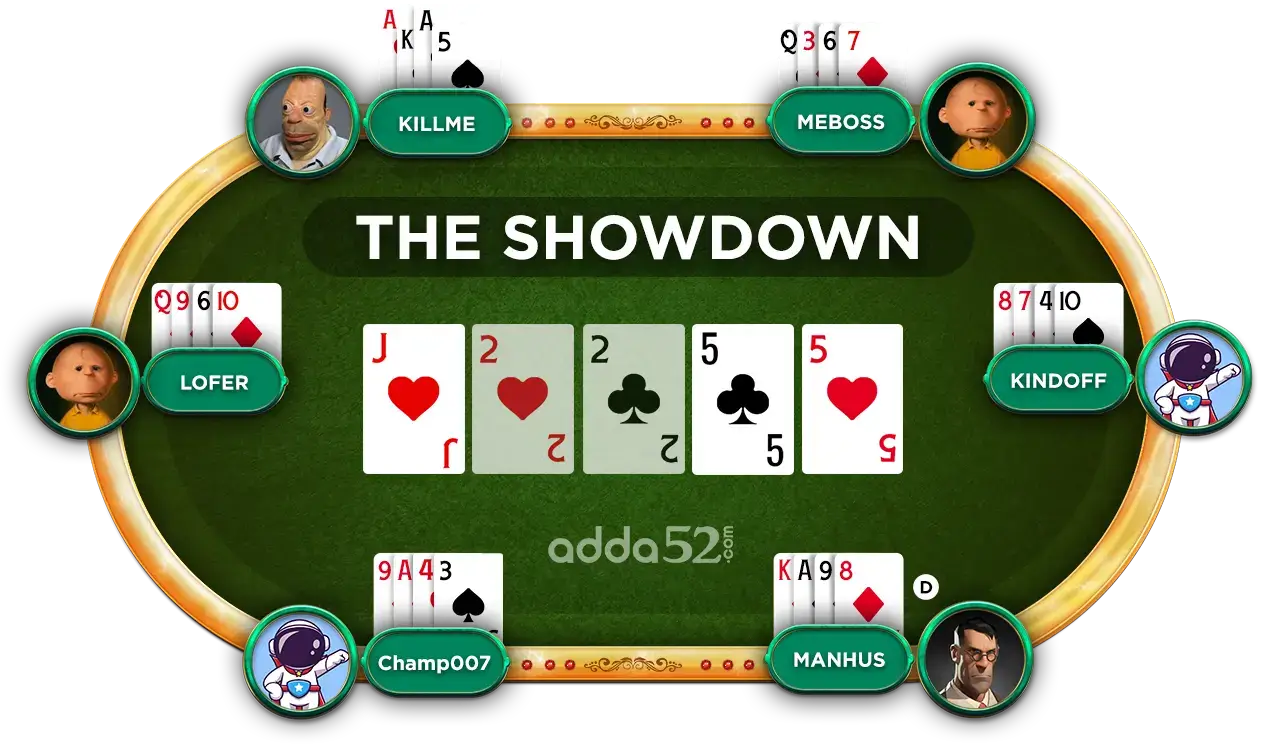
The Actions
Betting Actions
Betting actions refer to the options available to a player when it is their turn to act during a betting round. The most common betting actions are:
- Bet: A player can bet if no bets have been made in the current betting round. This means the player is the first to put money in the pot during the betting round.
- Call: A player can choose to call if a bet has been made in the current betting round. This means the player matches the current bet and continues playing the hand.
- Fold: A player can fold their hand if they do not want to continue playing the current hand. When a player folds, their cards and money already invested in the pot are forfeited.
- Check: A player can check if no bets have been made in the current betting round. This allows the player to stay in the hand without making a bet.
- Raise: A player can choose to raise if a bet has been made in the current betting round. This means the player increases the current bet and continues playing the hand.
- All-in: A player can choose to go all-in if they do not have enough chips to make a bet or raise. This means that the player bets all of the chips they have remaining.
How to Bet in Poker
Here is the process of betting in poker:
- The player to the dealer's left (or the "small blind") places a small bet before dealing the cards. The player to the left of the small blind (or the "big blind") must place a larger bet.
- Once the hole cards have been dealt, the first round of betting begins with the player to the left of the big blind. This player has the option to call (match the big blind), raise (increase the bet), or fold (give up their hand and exit the round).
- The betting proceeds clockwise around the table, with each player having the same options.
- Once all players can act, the dealer will reveal the flop (three community cards) in Texas Hold'em and Omaha.
- Another round of betting begins with the player to the dealer's left.
- Once all players have acted, the dealer will reveal the turn (fourth community card).
- Another betting round occurs, followed by the river (Fifth community card).
- The final betting round begins with the player to the dealer's left, and then the remaining players reveal their hole cards.
- The player with the best hand wins the pot.
How to Deal in Poker
Dealing with poker involves distributing cards to the players at the table. The dealer is responsible for enforcing the game's rules, such as betting limits and proper card handling. Here is the basic process of dealing in a game of poker:
- The dealer shuffles the deck of cards thoroughly.
- He deals each player their hole cards (the cards that are dealt face down and kept hidden from other players). He starts with the player to their left and continues clockwise around the table.
- The dealer then deals the flop, turn, and river (community cards that are dealt face-up in the centre of the table) in Texas Hold'em and Omaha.
- After the final round of betting, the dealer will reveal the hole cards of the remaining players, and the hand with the best hand wins.
- The dealer button is then moved clockwise to the next player, and the process begins again.
Seeing and raising
Seeing and raising refers to an act of double-betting action by any player on a single move. For example, if a player initially calls and then immediately changes his decision to raise the bet instead, this scenario gives an added advantage to him as he can adjust his strategy based on his opponent's reactions. Many tables discourage string betting because players can act only once in a single move.
Limit vs No Limit
No Limit
- In no-limit poker, there are no predetermined betting limits
- Players can bet any amount of their chips at any time during a hand, including going all-in, risking their entire stack
- The absence of betting limits adds an element of unpredictability and allows for more significant swings in chip stacks
Limit
- In limit poker, there's a predetermined betting limit for each round
- Players can only bet or raise by a fixed amount, typically set before the game starts
- The betting limits restrict the amount of money a player can wager, providing a more controlled and predictable environment
Poker Etiquette
Poker etiquette is essential for maintaining a positive and fair gaming environment. It involves respecting fellow players, refraining from excessive conversation during hands to ensure focus, avoiding the show of cards when folding to prevent influencing the game and making decisions promptly to keep the game flowing smoothly.
Furthermore, players are expected to adhere to a strict code of honesty, refraining from cheating or engaging in unethical behaviour during the game. Abiding by this code not only fosters a more enjoyable atmosphere but also maintains the integrity of the game.
Variations in Poker
There are many variations of poker, each with its own rules and strategies. Here are a few examples of the most popular poker variations:
-
Texas Hold'em:
Texas Hold’em poker is the most popular variation played with two-hole cards and five community cards. The game aims to make the best five-card hand using any combination of the hole cards and community cards.
-
Pot Limit Omaha:
Pot Limit Omaha is similar to Texas Hold'em, but each player is dealt four hole cards and must use exactly two of them in combination with the five community cards to make the best hand. PLO4, PLO5 and PLO are the most popular forms of Omaha Poker.
-
Seven-Card Stud:
This variation is played with seven cards per player, five community cards and two hole cards. The goal is to make the best five-card hand using any combination of the seven cards.
-
Razz:
Razz is a variation of the Seven-card stud, but the goal is to make the lowest possible hand rather than the highest. Straights and Flushes do not count against the player, and the best hand is A-2-3-4-5.
-
Draw Poker:
This variation is played with five cards per player, allowing players to discard and replace cards to improve their hands. The most popular Draw Poker variant is the 5-card Draw.
-
Caribbean Stud Poker:
This variation is played against the house rather than against other players. The goal is to make a better hand than the dealer, and the game uses a traditional poker hand system.
-
H.O.R.S.E:
It is a mixed-game format that allows players to play several poker variations in one round, including Texas Hold'em, Omaha Hi-Lo, Razz, Seven-card Stud, and Seven-card Stud Hi-Lo.
Poker Card Rules to Play Poker
Poker Rules to Play No Limit Texas Hold’em Poker
Here are the basic poker card rules for playing No Limit Texas Hold'em:
- Each player is dealt two hole cards (face down) and five community cards (face up) in the centre of the table.
- The game aims to make the best five-card hand using any combination of the two-hole cards and the five community cards.
- The player to the left of the dealer (the "small blind") must place a small blind, and the player to the left of the small blind (the "big blind") must put a big blind. The big blind is usually twice the amount of the small blind.
- The first betting round begins with the player to the left of the big blind. This player has the option to call (match the big blind), raise (increase the bet), or fold (give up their hand and exit the round)
- The betting then proceeds clockwise around the table. In No Limit Texas Hold'em, there is no maximum bet, so players can bet any amount of chips they have in front of them.
- Once all players have had a chance to act, the dealer will reveal the flop, turn, and river (community cards)
- Another round of betting begins with the player to the dealer's left.
- Once all players have had a chance to act, the dealer will reveal the turn and river.
- The final betting round begins with the player to the dealer's left, and then the remaining players reveal their hole cards.
- The player with the best hand wins the pot.
Rules of Poker To Play Pot Limit Omaha Poker
Here are the poker game rules for playing Pot Limit Omaha:
- Each player is dealt four hole cards (face down) and five community cards (face up) in the centre of the table.
- The goal is to make the best five-card hand using exactly two of the four-hole cards and three of the five community cards.
- The rest of the game's rules are similar to Texas Hold’em.
Poker Rules To Play Pot Limit 5-Card Omaha
Here are the poker game rules for playing Pot Limit 5-Card Omaha:
- Each player is dealt five hole cards (face down), and five community cards (face up) are dealt in the centre of the table.
- The game aims to make the best five-card hand using three of the five-hole cards and two of the five community cards.
- The rest of the playing rules are similar to Pot Limit Omaha. Pot Limit 5-Card Omaha is often considered a more "action-packed" game than Pot Limit Omaha because players have more options and the potential for bigger pots.
Table Stakes in Poker
Cash Game Stakes
Whenever you enter a cash game, you see a listing with ₹10/₹20 NL Hold’em, or ₹15/₹30 Limit Hold’em.
₹10/₹20 No limit Hold’em means a game with no limit on the pot with a small blind of 10 and a big blind of 20. Whereas ₹15/₹30 Limit Hold’em means the pot value is predetermined; you can bet up to a limit. The small and big blinds are 15 and 30, respectively.
Tournament Stakes
To participate in a tournament, you will pay a fixed amount called buy-in. The number of blinds in tournaments keeps increasing, making it more challenging. The tournament chips have no value; the buy-in determines the prize pool.
Frequently Asked Questions
What is the highest card in poker?
The highest card is the Ace. It can help you win if your opponents don't have a better hand.
How do you play basic poker?
To play basic poker, get familiar with hand rankings, understand the betting rounds, and learn when to hold, fold, or bet. Start with simple versions like Texas Hold'em and build your strategy from there.
What Are Hole Cards?
Hole cards are the face-down cards dealt to each player. These cards are only visible to the individual player and are combined with the community cards to make the best possible hand.
What are Community Cards?
Community cards are dealt face-up on the board in three rounds: the flop, the turn, and the river. All players share these cards in the game, combined with a player's hole cards to make the best possible hand.
How to play a poker game with rules?
Community cards are dealt face-up on the board in three rounds: the flop, the turn, and the river. All players share these cards in the game, combined with a player's hole cards to make the best possible hand.
How to play HORSE poker rules?
Community cards are dealt face-up on the board in three rounds: the flop, the turn, and the river. All players share these cards in the game, combined with a player's hole cards to make the best possible hand.
How do you play Omaha poker with rules?
Community cards are dealt face-up on the board in three rounds: the flop, the turn, and the river. All players share these cards in the game, combined with a player's hole cards to make the best possible hand.
Conclusion
Mastering poker requires learning the game rules and effectively leveraging the game's strategic elements. Understanding poker rules, ranging from hand rankings to betting actions, is critical to gaining success in this game.
As players progress from beginners to more experienced players, incorporating advanced tactics and strategy becomes essential. Playing poker on platforms like Adda52 offers a risk-free environment to practice. Players who want to learn how to play poker should start with the basics. From there, exploring different techniques and engaging in actual gameplay will build proficiency and confidence.
